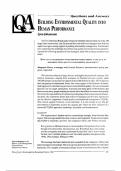BUILDING
ENVIRONMENTAL
HUMANPERFORMANCE
Lynn Johannson
QUALITY
INTOzy
zyxw
zyxwvu
Questions and Answers zy
A U.S. Conference Board study released in October indicated that out of the 150
large firms interviewed, only 25 percent believed mid-level managers and first line
supervisors gave strong support to pushing total quality management. Practitioners
have stated that this challenge also affects total quality environmental management.
I posed the following question to four managers, each with a unique perspective to
share:
H O W CAN A N ORGANIZATION OVERCOME BEHAVIORAL INERTIA IN THE RACE TO
IMPLEMENT TOTAL QUALITY ENVIRONMENTAL MANAGEMENT?
Margaret Glover, a manager with General Electric’s environmental quality pro-
gram, responded:
GE is best described as alarge, diverse, and highly decentralized company. Our
thirteen businesses, ranging from aerospace to financial services, employ about
290,000 people &d account for approximately $60 billion in sales. GE recogmzes
that integrating environmental issues into every aspect of the business decision-
making process is the best way to ensure environmental quality. The environmental
function can no longer stand alone. It touches too many parts of the business and
there are too many people making decisions daily that affect environmental quality
for it to be the responsibility of a relatively small group of environmental profession-
als alone. Our experience shows that mid-level managers and first line supervisors
can be effective supporters of total quality environmental management (TQEM).
This critical support, however, is not automatic. It is not enough to say that the
environment is important, so let’s do a quality job. There are three elements of a
successful TQEM approach: leadership, education, and measurement.
LEADERSHIP
The organization’s leaders need to communicate strongly what behavior they
that TQEM is important, and why. Our company’s CEO, Jack Welch, has said:
Every person in GE has to be an environmentalist. Our products have to be
thought of in those terms. Ourprocesses, too. Everybody has a role to play.
zy
expect. The message needs to be clear, concise, and consistent. People need to know
zyxwvutsrqponml
And the companies that don’t understand this and don’t do it, won’t recruit
zyxwvutsrq thebest. won’t selltheirproducts, won’t beviable,positiveenterprises in the
zyxwvutsrqp
zyxwvutsrqpon zyxwvuts
1990s. [First Edition, February 19901
Lynn Johannson is the
This message has been reinforced and expanded in the company’s officer and
director of E2 Management
Corporation in senior management meetings. The message has also taken hold within our individual
Georgetown, Ontario. businesses. For example, every plant manager in one of our businesses has a signed
TUTALQUALITYENVIRONMENTAL
MANAGEMEATISPRING
1992 295
, LYNN JOHANNSON
zyxwv
statement of commitment to environmental performance. This statement, made into
a banner, is displayed prominently in every plant.
zy
EDUCATION
The organization needs to be clear about how to get the behavior it desires. It is
not enough to set a goal without enabling and empowering people to reach the goal.
At GE, environmental awareness begins at the officer and seniormanagement levels
at their regularly scheduled meetings. Environmental issues and concerns are also
integrated into the key courses offered through the company’s management devel-
opment programs. There is even an environmental course designed specifically for
plant managers and their staffs. In addition, environmental best practices are shared
zyx
through an electronic bulletin board accessible to the entire company.
MEASUREMEW
The organization needs to establish clear measurements to ensure that it has
zyxw
achieved the behavior and results it wants. There may be more than one set of
zyxwv
measurements, but they must be complementary with each other and with other
measurement systems adopted by the organization. For example, GE’s PULSE
program reviews every aspect of environmental compliance performance at each
facility. PULSE has been complemented by another evaluation process, the manage-
Measures should do ment systems assessment (MSA). While PULSE looks at what compliance problems
zyxwvutsrq
more than track occur, MSA looks at the root cause ofwhy those problems arise. This approach has
progress, however. been enormously effective because it focuses on the behavior and systems that are
They must be tied to necessary to achieve environmental goals while suggesting the solutions to problems
recognition systems that surface during ’theassessment.
that also convey the Compliance performance, employee illness and injury reduction, and waste
leadership’s priorities. minimization are all measures that can be quantified and that reveal much about a
company’s implementation of TQEM. Below the mid-management level, where
performance is more difficult to affect directly, these measures may need to be
augmented with activity-based ones, such as training programs, job hazard analyses,
and worker involvement in environmental teams. Measures should do more than
zyx
track progress, however. They must be tied to recognition systems that also convey
the leadership’s priorities. There should be real consequences to meeting, falling
short of, or exceeding goals. GE is tying environmental performance to its incentive
compensation program. Some of ourbusinesses are also looking at an environmental
recognition system for all levels within the organization.
CONSIDERATIONS
OTHER
In addition to leadership. education, and measurement, there are some other
considerations worth mentioning. First, any company’s approach to TQEM must be
consistent with that company’s culture and other major initiatives underway. While
there is no cookie-cutter approach, it would be extremely difficult to institute TQEM
if the company hasnot yetembracedquality as apriority. Otherinitiatives, evenones
not explicitly called “quality” programs, can provide an important boost for TQEM
if they have already helped generate interest and momentum.
A related point is the need for allies. Effective environmental management is not
a single-function responsibility. Many people in the organization play key roles in
improving environmental quality. Engineering, production, marketing, sourcing,
human relations, finance, and legal depamnents should all be viewed as potential
partners of the environmental function. Quality in those areas is, in part, a function
296 T ~ AQL u m ENVIRONMENM
MANAGEMW~~SPRING
1992




